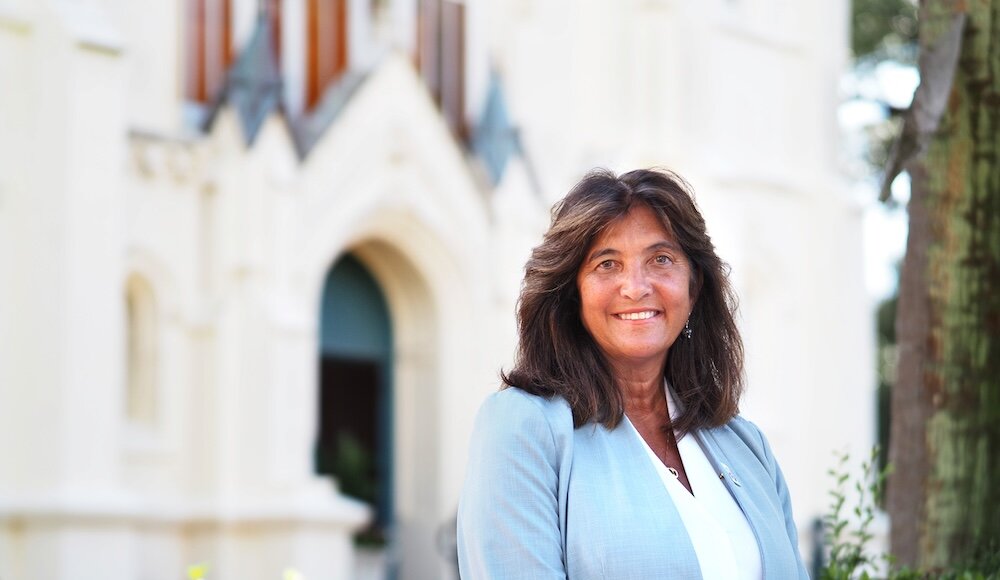
In Mobile, where idyllic oak trees sway and history abound, sits Alabama’s oldest college. Spring Hill College was established in 1830 by Bishop Michael Portier, Mobile’s first Catholic bishop. It holds several other distinctions in higher education. It is the first Catholic college in the Southeast, the 3rd-oldest Jesuit college and the 5th-oldest Catholic college in the United States.
“Throughout Spring Hill College’s history, we have constantly evolved,” says Spring Hill College President Mary Van Brunt. “Spring Hill has always been a trendsetter.”
The college has indeed championed changes before they became mainstream, from being the first and only integrated college in the Deep South for a decade beginning in the 1950s to its student center being the first green building of its size in Mobile when it broke ground in 2009.
Today, Spring Hill looks again to evolution to address new challenges. An ever-changing enrollment and financial landscape create hurdles for the historic college in the modern day.
“The number of students graduating is reducing across the country,” says Van Brunt. “Some rhetoric now asks, ‘What’s the value of a college education?’ You have to be innovative and creative to battle those problems.”

Known for its beautiful campus and Jesuit education, the private college has a small student body and a 13:1 student-teacher ratio. Before Van Brunt became president in 2023, the college tried several strategies to increase enrollment and finances, including cutting tuition in half from $42,000 in 2020 to $21,100 in the fall of 2021. Last year’s tuition totaled $23,504.
Price resets are common practice in higher education, Van Brunt explains. “Colleges have a high sticker price and then give big scholarships,” says Van Brunt. “Tuition may be $50,000, but they give $30,000 in scholarships, so it really only costs $20,000.” To attract more students, some colleges list the net price instead of the inflated version. While logical in theory, one factor has an unexpected impact. “You’re fighting now against people perceiving that your value has changed when it hasn’t,” says Van Brunt. “I don’t know many colleges that are successful with the price reset, given other colleges’ high sticker price.”
Regardless of trial and error, Van Brunt says that change is inevitable in today’s higher education world. The college is continuously monitoring how to offer the most effective programs, attract students and maintain its impact in south Alabama.
“What we have at Spring Hill is a sense of urgency to face these challenges,” says Van Brunt. “It’s a little bit of a culture change.” One of the biggest enrollment changes at Spring Hill over the past few years has been an increase in retention of first-year students. Spring Hill College Provost and Chief Academic Officer Rebecca Cantor credits a large part of this to the college’s $2.2 million Title III grant, efforts by faculty and staff and increased support of commuter students. “Our year-over-year retention rate has gone up by 8% in just two years,” Cantor says.
The culture change continues in Spring Hill’s academic programs. In February, Spring Hill College cut six majors: chemistry, biochemistry, history, philosophy, secondary education and studio art. With just 33 students enrolled in those programs, under-enrollment was the ultimate decision-maker. “It reflected a change in what students are looking for and the workforce now demands,” says Van Brunt. “It wasn’t easy to do, but it gave us the funding to refocus on programs that are in demand.”
Spring Hill College invested in developing and introducing new majors that reflect a changing world. Of those majors, AI and data science, strategic communication, and digital communication and social influence launched this fall; an exercise science major will follow next fall. “Some students who started this fall are interested in these programs and others who were already taking classes want to switch to them,” says Van Brunt. “We expect to have more interest next fall as we really recruit and market them.”
Partnerships are a new avenue Spring Hill is exploring. Smaller institutions often cannot afford to offer a wide range of classes to a small student body. Partnerships let schools expand their offerings together. Spring Hill recently reached an agreement with Rockhurst University in Kansas City, another Jesuit college, that Cantor refers to as “a win-win partnership.”
Students across both colleges can take online classes from each institution. The move helps Spring Hill financially, allowing the college to be more strategic about what classes it offers and giving its students a broader curriculum. “The classes fill more, creating a more robust learning experience,” says Van Brunt. “It’s an alliance that asks, ‘How can we be better together?’” The partnership offers Spring Hill students a path to enroll in Rockhurst’s master’s and doctoral programs, and Rockhurst University students have access to Spring Hill College’s Italy Center in Bologna.
Spring Hill College’s latest investment in its medical students comes in the form of a new partnership with Kansas City University. A select number of Spring Hill students will experience Kansas City University’s osteopathic medicine school and dental program. “Osteopathic medicine is the care of the whole person, which fits perfectly into our Jesuit mission, the care of the whole person,” says Van Brunt. She says 100% of Spring Hill’s pre-med students are accepted into medical school. This new agreement will help Spring Hill attract undergraduate students with a direct path to medical or dental school.

The medical students at Spring Hill College have something new to look forward to on campus. The Annette N. Shelby Health and Science Innovation Center had its groundbreaking this summer. The building will house the college’s science, health sciences and nursing programs, giving students state-of-the-art equipment and technology — such as digital cadavers, high-tech labs and collaborative classrooms — to further their education.
Renderings show a modern building with classic architectural elements echoed across Spring Hill’s campus, combining history with a glimpse into the future. Van Brunt says the 57,000-square-foot center, slated to open in the spring of 2027, is a transformational investment in Spring Hill’s future, helping fill workforce demand and address shortages in the health care field. “This enables us to form the health care leadership right on the Gulf Coast,” she says.
Just five years away from the college’s bicentennial, Spring Hill leadership is optimistic about the future. “We believe in the power of connection to our community,” says Cantor. “We are very proud that so many of the incredible nurses, judges, doctors, teachers and leaders on the coast are Spring Hill College grads.” With $13 million raised over just the past two years, the foundation is being laid for Spring Hill’s future history. “We’ve engaged our alumni and improved our donor recruitment,” says Van Brunt. “That goes to scholarships, goes to academic innovation, like these partnerships, and it goes to growth on campus.”
Change, Van Brunt says, is an element of Spring Hill’s past and key to its future. “You have to find a way to pivot and ask, ‘What now?’” says Van Brunt. “The legacy of Jesuit Catholic education is not just our past; it’s our foundation and who we are. We’ve been doing it for almost 200 years, so we’re excited about the outlook and the changes and where we’re going to end up.”
Amelia Rose Zimlich is a staff writer for Mobile Bay magazine and a special contributor to Business Alabama. Mike Kittrell is a Mobile-based freelance contributor.
This article appears in the November 2025 issue of Business Alabama.



